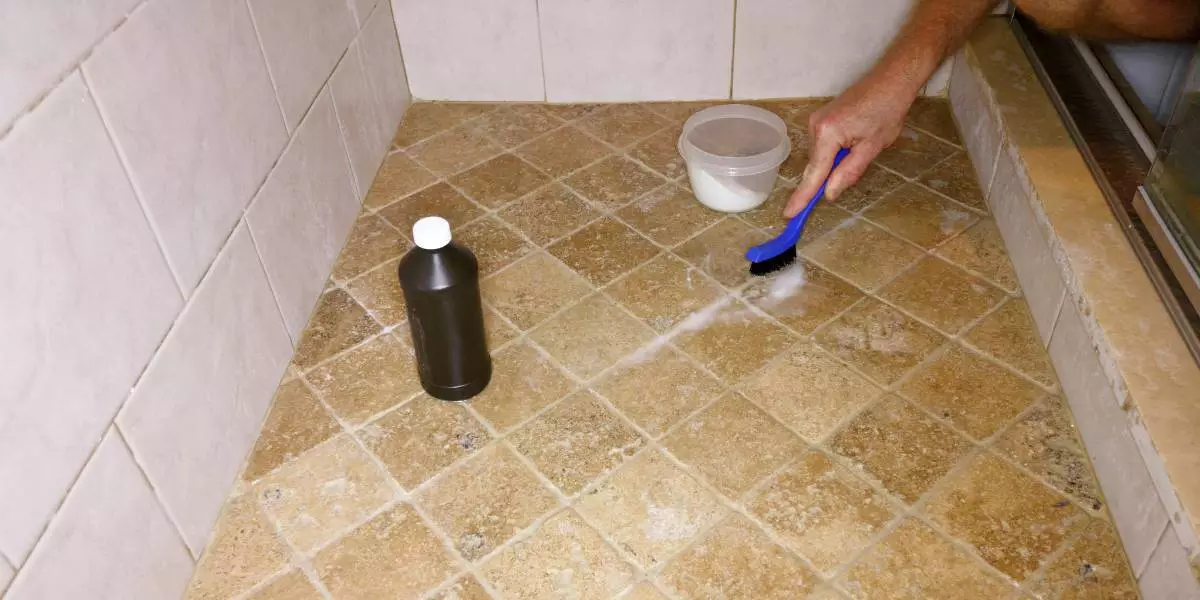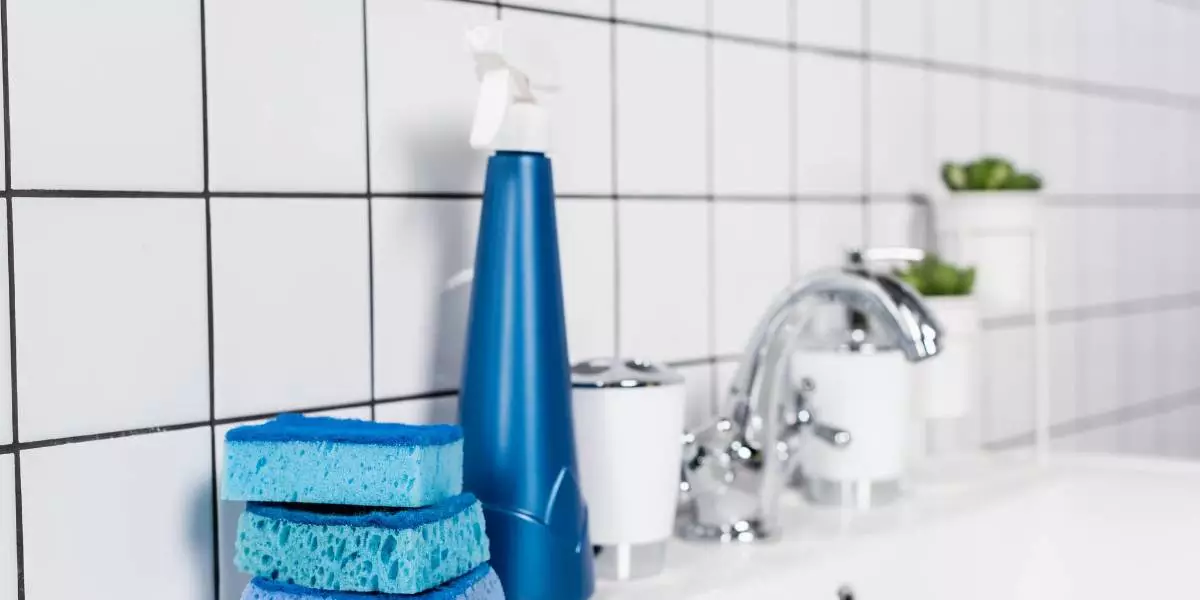Are you tired of looking at dirty grout in your bathroom or kitchen? It’s time to bring back the sparkle to your tiled surfaces! In this article, you will discover simple and effective methods to clean grout, leaving it spotless and looking like new. Forget about spending hours scrubbing in frustration – with these easy-to-follow steps, you’ll have clean grout in no time. Say goodbye to stains and hello to a fresh and revitalized space!
Preparation
Before you begin the process of cleaning your grout, it’s important to have all the necessary materials gathered and ready. Having everything within reach will make the cleaning process much smoother and more efficient. Here are a few items you’ll need:
Gather Materials
To effectively clean your grout, you will need a few basic supplies. These include:
- Baking soda
- Vinegar
- Hydrogen peroxide
- Lemon juice
- Salt
- Grout cleaner sprays
- Grout pen
Clear the Area
Before you start cleaning, it’s essential to clear the area around the grout lines. This will prevent any accidental spills or damage to nearby objects. Remove any furniture or decorative items, and ensure the floor or wall surface is clear and accessible for cleaning.
Protect Surrounding Surfaces
It’s always a good idea to protect your surrounding surfaces from any potential splatters or spills during the cleaning process. You can cover adjacent tiles or countertops with plastic sheets or towels to prevent any damage from the cleaning solutions or sprays.
Natural Cleaning Solutions
If you prefer using natural cleaning solutions, there are a few effective options for cleaning grout. These solutions are not only environmentally friendly but also safe for your health.
Baking Soda and Vinegar
The combination of baking soda and vinegar is a powerful and natural cleaning solution for grout. Start by creating a paste by mixing baking soda and water. Apply this paste to the grout lines and let it sit for about 15 minutes. Then, spray vinegar onto the paste and scrub the grout using a toothbrush or grout brush. The mild abrasive nature of baking soda combined with the acidic properties of vinegar helps break down dirt and stains, leaving your grout looking clean and fresh.
Hydrogen Peroxide and Baking Soda
Another effective natural cleaning solution is a mixture of hydrogen peroxide and baking soda. Make a paste by mixing hydrogen peroxide and baking soda, and apply it to the grout lines. Allow the paste to sit for 10-15 minutes, then scrub the grout with a toothbrush or grout brush. Hydrogen peroxide acts as a gentle bleaching agent, while baking soda helps lift stains and dirt from the grout. This powerful combination can restore the original color and shine of your grout.
Lemon Juice and Salt
Lemon juice and salt can also be used to clean grout effectively. Mix equal parts of lemon juice and salt to form a paste. Apply the paste to the grout lines and let it sit for a few minutes. Then, scrub the grout with a toothbrush or grout brush. Lemon juice’s natural acidity helps dissolve grime and stains, while the salt acts as a gentle abrasive to scrub away any dirt or residue.
Commercial Cleaning Products
If you prefer using commercial cleaning products, there are various options available specifically designed to clean and restore grout. These products are convenient and often come in spray bottles, making the cleaning process even easier.
Grout Cleaner Sprays
Grout cleaner sprays are specifically formulated to target tough grime and stains. These sprays often contain ingredients like bleach or other powerful cleaning agents to break down dirt and restore the grout’s original color. Simply spray the cleaner directly onto the grout lines, let it sit for a few minutes, and then scrub with a toothbrush or grout brush. Rinse with water to remove any residue, and you’ll have clean, bright grout.
Grout Pen
A grout pen is a handy tool for touching up grout lines and restoring their original color. These pens come in various colors to match different grout shades and are easy to use. Simply apply the pen to the grout lines, following the grout’s natural pattern, and let it dry. The grout pen will cover up any stains or discoloration, giving your grout a fresh and uniform appearance.
Tools for Cleaning
Having the right tools is essential for effectively cleaning grout. Here are a few tools that will make your cleaning process easier and more efficient.
Toothbrush or Grout Brush
A toothbrush or grout brush is a small, narrow brush with firm bristles that allow you to scrub the grout lines thoroughly. A toothbrush works well for small areas, while a grout brush is ideal for larger surfaces. The bristles of these brushes can reach into the narrow gaps between the tiles, removing dirt and grime effectively.
Scrubbing Pad or Sponge
A scrubbing pad or sponge is another useful tool for cleaning grout. These tools have a slightly abrasive texture to help scrub away stubborn stains and grime. Gently scrubbing the grout lines with a scrubbing pad or sponge, either by hand or using a scrubbing pad attachment on a cleaning tool, can make a significant difference in the cleanliness and appearance of your grout.
Steam Cleaner
If you’re looking for a more efficient and powerful way to clean grout, consider using a steam cleaner. Steam cleaners use high-temperature steam to loosen and remove dirt and stains from grout. They are particularly effective for deep cleaning and sanitizing, as the heat kills bacteria and other microorganisms. Steam cleaners can be rented or purchased, making them a valuable investment for maintaining clean and hygienic grout.
Cleaning Process
Now that you have all the necessary materials and tools, it’s time to dive into the cleaning process itself. Follow these steps to clean your grout effectively.
Step 1: Sweep or Vacuum
Before applying any cleaning solution, start by sweeping or vacuuming the area around the grout lines. This removes loose dirt and debris, making the cleaning process more effective. It also prevents any dirt from getting trapped in the grout lines during the cleaning process.
Step 2: Spray Cleaning Solution
Next, apply your chosen cleaning solution to the grout lines. Whether you’re using a natural solution like baking soda and vinegar or a commercial grout cleaner spray, make sure to cover the grout lines evenly. Spray the solution directly onto the grout, making sure to saturate the lines thoroughly.
Step 3: Scrub the Grout Lines
Once you’ve applied the cleaning solution, it’s time to start scrubbing the grout lines. Use a toothbrush, grout brush, or scrubbing pad to scrub the grout lines in a back-and-forth motion. Apply gentle pressure to avoid damaging the grout or surrounding tiles. Focus on areas with visible stains or discoloration, giving them a little extra attention. Repeat this process for all the grout lines you want to clean.
Step 4: Rinse with Water
After you’ve scrubbed the grout lines, it’s important to rinse away any remaining cleaning solution. Use a clean damp cloth or sponge to wipe away the solution and any loosened dirt or grime. Rinse the cloth or sponge frequently to ensure you’re not spreading the dirt back onto the grout lines.
Step 5: Dry the Grout
Once you’ve rinsed the grout lines, it’s time to let them dry thoroughly. Use a clean, dry cloth or towel to pat the grout lines dry. Ensure that no moisture remains, as this can lead to the growth of mold or mildew. Leave the area to air dry completely before replacing any furniture or decorative items.
Deep Cleaning Techniques
In some cases, regular cleaning may not be enough to tackle tough stains or deeply embedded dirt in your grout. In such situations, it’s helpful to employ deep cleaning techniques to restore the grout’s original appearance.
Using Oxygen Bleach
Oxygen bleach is a safe and effective deep cleaning agent that can penetrate the grout’s pores and remove deep-seated dirt and stains. Mix the oxygen bleach with warm water according to the manufacturer’s instructions, and apply the solution to the grout lines. Let it sit for the recommended time, then scrub with a toothbrush or grout brush. Rinse thoroughly with water to remove any residue.
Steam Cleaning
Steam cleaning is an excellent method for deep cleaning grout, especially for large areas or heavily soiled grout lines. Using a steam cleaner, direct the steam onto the grout lines and move the tool back and forth to loosen dirt and stains. The high-temperature steam effectively sanitizes the grout, eliminating bacteria and germs. Remember to follow the manufacturer’s instructions and take necessary safety precautions when using a steam cleaner.
Grout Renewal Products
If your grout is severely stained or damaged, grout renewal products can be a game-changer. These products are specifically designed to restore the appearance and strength of grout. Follow the manufacturer’s instructions to apply the grout renewal product over the existing grout. These products typically come in a variety of colors, allowing you to match the grout’s original shade or change it entirely. With grout renewal products, you can give your grout a fresh, new look without having to completely replace it.
Preventive Measures
Taking preventive measures can help prolong the cleanliness and durability of your grout. By implementing these measures, you can reduce the frequency and intensity of deep cleaning sessions and maintain your grout in good condition.
Sealing the Grout
One effective preventive measure is to seal the grout. Grout sealer creates a protective barrier that prevents dirt, stains, and moisture from penetrating the grout lines. Apply the grout sealer following the manufacturer’s instructions, ensuring an even and thorough application. Regularly reapply the sealer according to the recommended timeframe or when you notice the grout becoming more porous or stained.
Regular Maintenance
Regularly maintaining and cleaning your grout can prevent dirt and stains from accumulating and becoming harder to remove. Incorporate a routine cleaning schedule into your cleaning routine, focusing on light cleaning and wiping down the grout lines with mild cleaning solutions. This will help keep the grout looking clean and prevent the need for more frequent deep cleaning sessions.
Using a Grout Brush
Using a grout brush regularly can help prevent the buildup of dirt and grime in your grout lines. A grout brush with stiff bristles can effectively remove surface-level dirt and prevent it from settling into the grout. Make it a habit to give your grout lines a quick scrub with a grout brush during regular cleaning sessions to maintain their cleanliness.
Removing Stubborn Stains
Sometimes, stains can be particularly stubborn and require some extra effort to remove. Here are a few methods to tackle those tough stains on your grout lines.
Using Vinegar and Baking Soda Paste
Create a paste by mixing vinegar and baking soda until you have a thick consistency. Apply the paste directly to the stained areas of the grout lines and let it sit for about 15 minutes. Gently scrub the paste into the grout using a toothbrush or grout brush, focusing on the stained areas. Rinse with water and repeat the process if necessary. This method can effectively remove tough stains, leaving your grout looking clean and fresh.
Hydrogen Peroxide Solution
A hydrogen peroxide solution can also be effective in removing stubborn stains from grout. Mix hydrogen peroxide with water in equal parts, and apply the solution to the stained areas of the grout lines. Let it sit for about 15-20 minutes, allowing the hydrogen peroxide to break down the stain. Scrub the grout lines with a toothbrush or grout brush, and rinse with water. This method can help lift even the most stubborn stains, restoring the grout’s original appearance.
Grout Pen for Stain Cover-up
If all else fails and you’re dealing with a stubborn stain that won’t budge, a grout pen can come to the rescue. Grout pens are designed to cover up stains and discoloration, giving your grout lines a fresh, uniform look. Simply apply the grout pen directly over the stained areas, following the grout’s natural pattern. Allow it to dry completely before using the area again. This quick and easy fix can save you the hassle of trying to remove an unyielding stain.
Cleaning Different Types of Grout
Different types of grout require slightly different cleaning approaches. Here are some tips for cleaning specific types of grout commonly found in households.
Ceramic Tile Grout
Ceramic tile grout is often used in kitchens and bathrooms. It’s important to clean ceramic tile grout regularly to prevent the buildup of dirt and grime. Follow the general cleaning process mentioned earlier, using a mild cleaning solution or natural cleaners. Avoid using harsh or acidic cleaners, as they can erode the grout over time.
Porcelain Tile Grout
Porcelain tile grout is typically more durable and resistant to staining compared to other types of grout. However, it still requires regular cleaning and maintenance. Use mild cleaning solutions or natural cleaners to avoid damaging the grout. Scrub the grout lines gently using a toothbrush or grout brush, paying attention to any stains or soiled areas.
Natural Stone Grout
Natural stone grout, such as grout used with marble or granite tiles, requires special care due to the porous nature of the stone. Avoid using acidic or abrasive cleaners that can damage the stone or grout. Instead, opt for pH-neutral cleaners specifically formulated for natural stone. Seal the grout regularly to protect it from staining, and wipe up spills promptly to prevent them from seeping into the porous grout lines.
Safety Tips
While cleaning grout is generally safe, it’s important to take precautions to protect yourself and your surroundings. Here are some safety tips to keep in mind during the cleaning process.
Use Gloves and Eye Protection
When working with cleaning solutions or chemicals, always wear gloves to protect your hands. Additionally, consider wearing eye protection, especially when using sprays or scrubbing vigorously. This will help prevent any accidental splashes or contact with chemicals.
Ventilate the Area
When using cleaning sprays or solutions that emit strong odors, ensure that the area is well-ventilated. Open windows or turn on fans to allow fresh air to circulate. Good ventilation not only helps with odor control but also prevents inhaling any potentially harmful fumes.
Avoid Mixing Chemicals
It’s crucial to never mix different cleaning chemicals together, as they can produce harmful fumes or even dangerous reactions. Read the labels of all cleaning products and adhere to any safety instructions or warnings. If in doubt, stick to one cleaning solution or consult a professional for guidance.
Cleaning grout can be a rewarding task that revitalizes the appearance of your tiles and brings a fresh and clean vibe to your home. By following the comprehensive steps and tips outlined in this article, you’ll be able to clean your grout effectively, whether you choose natural cleaning solutions or commercial products. Remember to take preventive measures and address stains promptly to keep your grout looking pristine for years to come.







